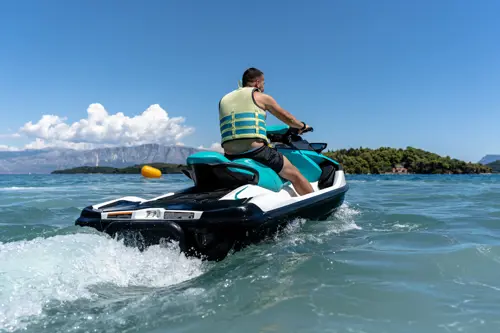How fast does a jet ski go? We answer the most common FAQs
14 November 2025

Whether you own a jet ski, are considering buying a personal watercraft (PWC), or have an interest in these fun leisure vehicles, you’ll find all you need to know in our jet ski FAQS.
From the different types of jet skis and where you can ride them to the safety equipment you need and how fast a jet ski goes, you’ll find the answers to your questions here.
What are the different types of jet ski?

A jet ski is a type of personal watercraft. In fact, the term ‘jet ski’ is a brand name created by the Japanese corporation Kawasaki. Other popular types of personal watercraft include WaveRunners and Sea-Doos.
Before buying a jet ski, it’s important to consider how you’re going to use it, as this will help you determine which type is best for you. There are two types of jet skis to choose from: a ‘runabout’ or a ‘stand-up’. A runabout craft has space for the rider to sit down and typically holds two or more people, whereas the stand-up is designed for a solo rider who uses it standing up.
Who can ride a jet ski?
Legally, anyone can ride a jet ski. There aren't any restrictions in the UK, and you don't need to hold a licence to ride or own a PWC. However, it's a good idea to check with your jet ski insurance provider to ensure there are no specific requirements or cover restrictions related to their policy.
Passengers who are not operating the PWC must sit behind the rider. If a passenger is too small to sit on the back and hold onto the rider, they unfortunately can’t be on board.
Do I need to complete a jet ski training course?
There isn’t a legal requirement in most parts of the UK to have a licence or take a course to use a jet ski for personal use in open waters. However, some local councils and harbour boards require jet ski riders to have a certificate or permit to use the water under their authority. It’s also likely you’ll need a licence or certificate to use your jet ski abroad in places like France, Spain, and Portugal.
The RYA is a valuable resource for additional information and in-depth courses for jet ski riders, particularly the RYA’s Personal Watercraft Proficiency Course, which can be completed in one day and provides reassurance and skill-building to ensure safe and confident adventures. Seeking to increase your confidence as a solo sailor? Jet ski clubs are a great way to get out on the water and meet other jet ski enthusiasts.
If you’d like to give jet skiing a try before you buy your own, water sport centres are a fantastic option and can welcome people of all abilities.
Are there any weight restrictions?
Yes, there are weight restrictions for riding a jet ski. However, they aren't legal restrictions, but rather manufacturer-specified limits that are important for safety, performance, and warranty reasons. Each jet ski has a maximum weight capacity which includes the rider (and passengers where applicable), fuel, and any equipment and personal belongings on board. Typically, jet ski weight restrictions are set between 400lbs and 600lbs.
Check the owner’s manual that came with your personal watercraft to see the maximum weight your jet ski can carry. Exceeding the weight restriction could result in reduced stability and handling, increased risk of capsizing or sinking, engine strain and performance issues, voided warranty or insurance problems, and even legal issues if an accident occurs due to overloading.
What safety equipment do I need to ride a jet ski?
When riding a jet ski in the UK, it’s often required by law or local regulations to wear an approved life jacket with a whistle in case of emergencies. If you or your passengers don’t wear a life jacket on your jet ski, this can result in fines, denial of access, and serious injury.
Although it’s not mandatory, it’s also suggested that you wear a helmet and goggles to avoid injury, especially if you’re new to jet skiing. Deck shoes will give you better control of your personal watercraft, but again, these are not a legal requirement.
Besides a life jacket, you’re not currently required to wear any other safety gear, however:
- Riders should carry a fully charged fire extinguisher and a sound-producing device in the event of an emergency
- If you're riding a lanyard-type ignition, you must attach the lanyard to your clothing, wrist, or life jacket
It’s also important to remember you may only operate a PWC during daylight hours.
Where can I ride a jet ski?
You’re allowed to ride a jet ski in many places in the UK. However, there are some places where you may not be permitted to ride. These include:
Most UK rivers and canals, including those managed by the Canal & River Trust, the Environment Agency, and Scottish Canals
- Nature reserves and protected areas
- Private lakes and reservoirs without permission
- Busy harbours and commercial ports
- Some public beaches, especially during peak season
Always check signage to ensure you’re allowed to ride your jet ski and to see whether there are any seasonal restrictions.
If you want to take your jet ski abroad, you’ll need to contact your insurers to work out whether your cover can be extended.
What documentation do I need to own a jet ski?

You should keep the following documentation relating to your personal watercraft safely stored at all times:
- Boating licence (where applicable)
- Personal watercraft insurance
- Ownership documentation
- Any boating or safety certifications
What are the risks involved with riding a jet ski?
No matter how experienced you are, anyone can crash a jet ski or sustain an injury while riding. That’s why it’s so important to review riding rules before heading out onto the water. A lot of modern jet skis and PWCs will have their own extensive manuals, so it’s worth looking over yours to make sure you’re riding safely.
Jet ski risks to be wary of include:
- Collisions with other water users
- Falling off at speed
- Getting stranded due to mechanical failure
- Hitting submerged objects or running aground
- Weather hazards, like strong winds and rain
- Reboarding injuries
Is it easy to reboard a jet ski?
Reboarding your jet ski after falling off is relatively easy. PWCs come in two different varieties. One enables you to pre-set the idle speed before take-off, so when you fall off, it continues to circle around.
Should you fall off the second type, the engine cuts off with a special lanyard (engine kill switch), which must be properly attached to your clothing, wrist, or life jacket. This way, if you fall, the lanyard will go with you and kill the engine.
How do I maintain a jet ski?
Owning a PWC isn’t without its responsibilities. You need to ensure that you’re keeping up with routine maintenance, such as fuel checks, general cleaning, and using a protective cover when not in use. This will help extend the lifetime of your jet ski and improve its performance.
Internal checks
The key thing to remember when carrying out internal checks on your jet ski is that the engine has been turned off for at least five minutes, ensuring it’s safe to complete the inspection.
- Flush the engine – Flush your jet ski’s engine after every ride, as this will remove sand, algae, salt and weeds, helping to prevent corrosion and damage
- Check for fluid leaks – Check the bottom of the hull to see whether there have been any oil or coolant leaks
- Battery check – Check battery power to ensure your jet ski will start
- Dispose of old fuel – If you’re not sure how to remove old fuel from the engine, consult a jet ski expert who will be able to drain old fuel and dispose of it safely
- Engine mounts – Check your engine bolts to make sure they’re tightly secured. A great way to check this is to give the craft’s engine a good pull from either side and from the front. If there’s any movement, you’ll likely have a broken engine mount that needs attention.
- Lubricate the engine – Spray some anti-corrosive lubricant over the engine after you’ve run your engine checks. Focus on the parts that might rust if saltwater hasn’t been removed.
- Check your oil level – Check the oil level after letting your jet ski run for a little while. Every PWC is different, so it's essential to consult your manual. Typically, you should let your jet ski run for around 30 seconds before checking your oil level.
- Coolant check – Don’t forget to do this before you leave. As a precaution, do not open the coolant lid until your jet ski engine is warm or hot.
Exterior checks
- Clean the exterior – After every trip on your jet ski, it will need to be cleaned. This stops any lingering saltwater from corroding metal parts. Thoroughly clean the jet ski, including wiping down the seat and windshield, to help prevent staining and corrosion.
- Clean the mirrors – To prevent the build-up of salt residue and limescale on your PWC, always clean and polish the mirrors with window cleaner to keep them in great condition.
- Check the hull – Check for cracks or chips on the hull that may allow water to enter, and ensure these imperfections are fixed before you head out again.
- Check for loose parts – Identify any loose screws or bolts and ensure they are tightened and fully secure before you venture out again.
Where can I store my jet ski?

There are several options for safely storing your jet ski. You could choose to store your vessel at home in your garage or garden, or use a storage unit to protect your jet ski from weather damage. You could also choose to dock your PWC at a marina or opt for dry racking.
The right choice for you depends on your budget and capacity to self-store. Beware of storing your vessel outside, as it may be subject to weather damage.
How much is a jet ski?
Owning a jet ski doesn’t come cheap. In addition to the initial purchase cost, you’ll need to budget for additional expenses, such as regular maintenance and upkeep, both of which are crucial for prolonging the life of your craft.
Jet ski prices can range anywhere between £5,000 and £20,000, depending on the make and model you choose. However, if you’re looking for a cheaper option, you may be able to buy a second-hand jet ski for as little as £2,000.
How fast does a jet ski go?
Jet skis can typically reach speeds of up to 60 mph, and some high-performance models can even exceed 70 mph, depending on the make and model of the watercraft. However, the average speed of a jet ski falls within the range of 35-45 mph, which is definitely fast enough to provide an exhilarating experience.
Specialist jet ski insurance through GJW Direct
Now you’ve gained all the information you need from our jet ski FAQs, you may want to consider specialist jet ski insurance. Specialist jet ski insurance through GJW Direct can help protect you and your jet ski against theft, damage, and third-party claims should anything happen while you're out on the water.
Get a quote today to see how much your cover could cost.
Please note the information provided on this page should not be taken as advice and has been written as a matter of opinion. For more on insurance cover and policy wording, see our homepage.
Got a question? Call our UK call centre 0151 473 8000
©Copyright Ripe Thinking Limited 2025. GJWDirect® is a registered trademark and a trading name of Ripe Insurance Services Limited which is Authorised and Regulated by the Financial Conduct Authority No.313411.
Registered office: The Royals, Altrincham Road, Manchester M22 4BJ. Registered in England No. 04507332.
